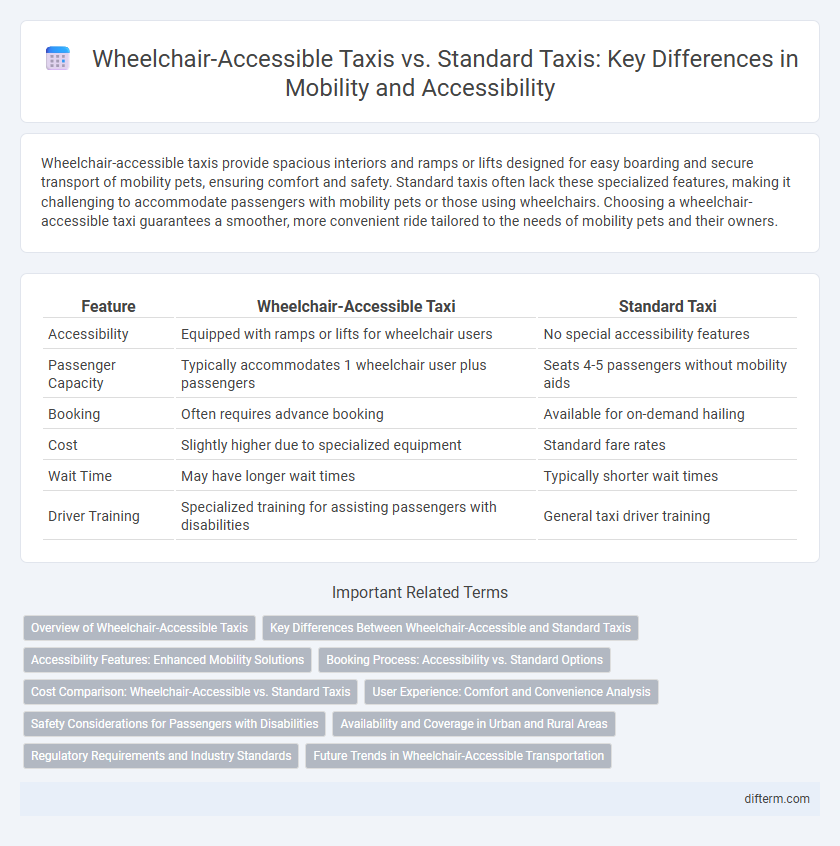Wheelchair-accessible taxis provide spacious interiors and ramps or lifts designed for easy boarding and secure transport of mobility pets, ensuring comfort and safety. Standard taxis often lack these specialized features, making it challenging to accommodate passengers with mobility pets or those using wheelchairs. Choosing a wheelchair-accessible taxi guarantees a smoother, more convenient ride tailored to the needs of mobility pets and their owners.
Table of Comparison
| Feature | Wheelchair-Accessible Taxi | Standard Taxi |
|---|---|---|
| Accessibility | Equipped with ramps or lifts for wheelchair users | No special accessibility features |
| Passenger Capacity | Typically accommodates 1 wheelchair user plus passengers | Seats 4-5 passengers without mobility aids |
| Booking | Often requires advance booking | Available for on-demand hailing |
| Cost | Slightly higher due to specialized equipment | Standard fare rates |
| Wait Time | May have longer wait times | Typically shorter wait times |
| Driver Training | Specialized training for assisting passengers with disabilities | General taxi driver training |
Overview of Wheelchair-Accessible Taxis
Wheelchair-accessible taxis are specially designed vehicles equipped with ramps or lifts, spacious interiors, and securement systems to accommodate passengers using wheelchairs safely and comfortably. These taxis comply with accessibility regulations and provide essential mobility options for individuals with disabilities, ensuring barrier-free transportation in urban environments. Unlike standard taxis, wheelchair-accessible vehicles prioritize ease of boarding and secure transport, significantly enhancing independence and travel convenience for wheelchair users.
Key Differences Between Wheelchair-Accessible and Standard Taxis
Wheelchair-accessible taxis feature ramps or lifts and spacious interiors designed to accommodate various wheelchair sizes, ensuring safe and comfortable transportation for passengers with mobility impairments. These vehicles are equipped with specialized securing systems that standard taxis lack, providing stability and safety during transit. Standard taxis typically have limited space and no adaptive equipment, making them unsuitable for wheelchair users who require accessibility features.
Accessibility Features: Enhanced Mobility Solutions
Wheelchair-accessible taxis feature ramps, widened doors, and secure wheelchair tie-downs, ensuring safe and convenient transportation for individuals with mobility impairments. These vehicles prioritize low-floor designs and automatic ramps, facilitating effortless boarding and disembarking compared to standard taxis. Accessibility enhancements in wheelchair-accessible taxis significantly improve travel independence and comfort for passengers using mobility aids.
Booking Process: Accessibility vs. Standard Options
Booking a wheelchair-accessible taxi typically involves specifying accessibility requirements through specialized apps or dedicated phone lines, ensuring vehicles are equipped with ramps or lifts for wheelchair users. Standard taxi booking options often lack these accessibility filters, leading to potential mismatches and delays for passengers with mobility needs. Integrating real-time tracking and accessibility verification enhances the user experience for accessible taxi services, contrasting with the general availability but limited customization of standard taxi bookings.
Cost Comparison: Wheelchair-Accessible vs. Standard Taxis
Wheelchair-accessible taxis typically cost more than standard taxis due to specialized equipment, lower vehicle availability, and increased maintenance expenses. On average, fares for accessible taxis can be 20-30% higher, reflecting the investment needed to accommodate mobility devices safely and comfortably. However, some cities offer subsidies or flat-rate programs to reduce the financial burden on passengers requiring wheelchair-accessible transportation.
User Experience: Comfort and Convenience Analysis
Wheelchair-accessible taxis offer enhanced user comfort with spacious interiors and secure wheelchair restraints, reducing physical strain during transit, unlike standard taxis which often lack these accommodations. The convenience of door-to-door service tailored for mobility device users significantly decreases travel time and effort compared to standard taxis. Features such as ramp deployment and lower entry points in wheelchair-accessible taxis improve safety and ease of access, optimizing the overall travel experience for passengers with disabilities.
Safety Considerations for Passengers with Disabilities
Wheelchair-accessible taxis are equipped with securement systems and ramps designed to safely accommodate passengers with mobility impairments, significantly reducing the risk of injury during transit. In contrast, standard taxis often lack these essential safety features, potentially compromising passenger stability and comfort. Prioritizing vehicles with accessibility certifications ensures compliance with safety regulations and provides a secure travel environment for individuals with disabilities.
Availability and Coverage in Urban and Rural Areas
Wheelchair-accessible taxis are more frequently available in urban areas due to higher demand and better infrastructure, while rural regions often face limited options and longer wait times. Standard taxis dominate coverage in both urban and rural zones, but they usually lack the necessary adaptations for passengers with mobility impairments. Expanding wheelchair-accessible taxi services in rural areas remains essential to ensuring equitable transportation access for all users.
Regulatory Requirements and Industry Standards
Wheelchair-accessible taxis must comply with strict regulatory requirements such as the Americans with Disabilities Act (ADA) and ISO 10865 standards, ensuring vehicles accommodate wheelchair dimensions and securement systems for passenger safety. Standard taxis typically follow general transportation regulations but lack specific mandates for accessibility features, often resulting in limited service for passengers with mobility challenges. Compliance with industry standards for wheelchair-accessible taxis promotes inclusivity, enhances service quality, and reduces legal liabilities for operators.
Future Trends in Wheelchair-Accessible Transportation
Future trends in wheelchair-accessible transportation emphasize integrating advanced technology such as autonomous vehicles and AI-driven ride-hailing platforms to enhance accessibility and efficiency. The adoption of electric wheelchair-accessible taxis is expected to grow, reducing carbon emissions while providing specialized features like adjustable ramps and securement systems. Urban planning increasingly prioritizes inclusive infrastructure, enabling seamless connectivity between accessible transit options and promoting greater mobility independence for wheelchair users.
Wheelchair-accessible taxi vs standard taxi Infographic

 difterm.com
difterm.com